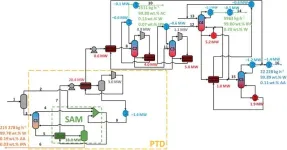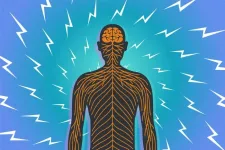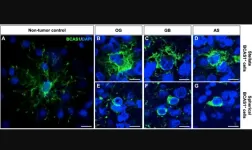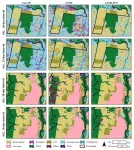(Press-News.org) Brigham and MIT researchers uncovered never-before-seen details in human brain tissue with new, inexpensive microscopy technology.
KEY TAKEAWAYS
Researchers have developed a new microscopy technology called decrowding expansion pathology (dExPath) to analyze brain tissue.
By pulling proteins apart with dExPath, researchers can stain proteins in tissue that could not be accessed before, highlighting nanometer sized structures or even cell populations that were previously hidden.
This “super-resolution imaging” technology has the potential to provide insights that could improve diagnostic strategies and patient outcomes.
Researchers from Brigham and Women’s Hospital, a founding member of Mass General Brigham, and the Massachusetts Institute of Technology (MIT) have unveiled unprecedentedly detailed images of brain cancer tissue through the use of a new microscopy technology called decrowding expansion pathology (dExPath).Their findings, published in Science Translational Medicine, provide novel insights into brain cancer development, with potential implications for advancing the diagnosis and treatment of aggressive neurological diseases.
“In the past, we have relied on expensive, super-resolution microscopes that only very well-funded labs could afford, required specialized training to use, and are often impractical for high-throughput analyses of brain tissues at the molecular level,” said Pablo Valdes, MD, PhD, a neurosurgery resident alumnus at the Brigham and lead author of the study. “This technology brings reliable, super-resolution imaging to the clinic, enabling scientists to study neurological diseases at a never-before-achieved nanoscale level on conventional clinical samples with conventional microscopes.”
Researchers previously relied on costly, super-high-resolution microscopes to image nanoscale structures in cells and brain tissue, and, even with the most advanced technology, they often struggled to effectively capture these structures at the nanoscale level.
Ed Boyden, PhD, the Y. Eva Tan Professor in Neurotechnology at MIT and co-senior author on this study, began addressing this problem by labeling tissues, and then chemically modifying them to enable uniform physical expansion of tissues. However, this expansion technology was far from perfect. Relying on enzymes known as proteases to break up tissue, scientists found that this chemical treatment with enzymes destroyed proteins before they could analyze them, leaving behind only a skeleton of the original structure, retaining only the labels.
Working together, Boyden and E. Antonio Chiocca, MD, PhD, Neurosurgery Chair at Brigham and Women’s Hospital and co-senior author on this study, mentored Valdes during his training as a neurosurgeon-scientist, to develop novel chemistries with dExPath to address the limitations of the original expansion technology.
Their new technology chemically modifies tissues by embedding them in a gel and ‘softening’ the tissues with a special chemical treatment that separates protein structures without destroying them and which allows tissues to expand. This provided exciting findings to the MIT and Brigham researchers, who routinely use commercially available antibodies to bind to and illuminate biomarkers in a sample. Antibodies, however, are large and many times cannot easily penetrate cell structures to reach their target. Now, by pulling proteins apart with dExPath, these same antibodies used for staining can penetrate spaces to bind proteins in tissue that could not be accessed before expansion, highlighting nanometer sized structures or even cell populations that were previously hidden.
“The human brain has several stop guards in place to protect itself from pathogens and environmental toxins. But these elements make studying brain activity challenging. It can be a bit like driving a car through mud and ditches. We cannot access certain cell structures in the brain because of barriers that stand in the way,” said E. Antonio Chiocca, MD, PhD, chair of the Department of Neurosurgery at the Brigham. “That is just is one of the reasons that this new technology could be so practice changing. If we can take more detailed and accurate images of brain tissue, we can identify more biomarkers and be better equipped to diagnose and treat aggressive brain diseases.”
To validate the effectiveness of dExPath, Boyden and Chiocca's team applied the technology to healthy human brain tissue, high and low-grade brain cancer tissues, and brain tissues affected by neurodegenerative diseases including Alzheimer’s and Parkinson’s diseases. Investigators stained tissue for brain and disease specific biomarkers and captured images before and after expanding samples with dExPath.
The results revealed uniform and consistent expansion of the tissue without distortion, enabling accurate analysis of protein structures. Additionally, dExPath effectively eliminated fluorescent signals in brain tissue called lipofuscin, which makes imaging of subcellular structures in brain tissues very difficult, further enhancing image quality. Further, dExPath provided stronger fluorescent signals for improved labeling as well as simultaneous labeling of up to 16 biomarkers in the same tissue specimen. Notably, dExPath imaging revealed that tumors previously classified as “low-grade” contained more aggressive features and cell populations, suggesting the tumor could become far more dangerous than anticipated.
While promising, dExPath requires validation on larger sample sizes before it can contribute to the diagnosis of neurological conditions such as brain cancer. Valdes underscores that, although still in its early stages, his team aspires for this technology to eventually serve as a diagnostic tool, ultimately enhancing patient outcomes.
"We hope that with this technology, we can better understand at the nanoscale levels the intricate workings of brain tumors and their interactions with the nervous system without depending on exorbitantly expensive lab equipment," said Valdes who is now an assistant professor of neurosurgery and Jennie Sealy Distinguished Chair in Neuroscience at the University of Texas Medical Branch. "The accessibility of dExPath will bring enable super-resolution imaging to understand biological processing at the nanometer level in human tissue in neuro-oncology and in neurological disease such as Alzheimer’s and Parkinson’s, and one day, could even improve diagnostic strategies and patient outcomes."
Authorship: Authors are Pablo Valdes (BWH and MIT), Chih-Chieh (Jay) Yu, Jenna Aronson, Debarati Ghosh, Yongxin Zhao, Bobae An (MIT), Joshua D. Bernstock (BWH and MIT), Deepak Bhere (BWH), Michelle M. Felicella, Mariano S. Viapiano, Khalid Shah (BWH), and co-corresponding senior authors E. Antonio Chiocca and Edward S. Boyden.
Disclosures: Valdes, Zhao, and Boyden have filed for patent protection on a subset of the technologies described. Yu is a co-inventor on two different expansion microscopy technologies. Bernstock has an equity position in Treovir Inc. and UpFront Diagnostics. Bernstock is also a co-founder of Centile Bioscience and on the NeuroX1 scientific advisory board. Boyden is cofounder of a company to help with commercial applications of expansion microscopy.
Funding: The study was supported by Lisa Yang, HHMI, John Doerr, Open Philanthropy, the Bill & Melinda Gates Foundation, the Koch Institute Frontier Research Program, NIH 1R01MH123403, NIH R56NS117465, NIH 1R01MH123977, NIH 1R56AG069192, NIH R01MH124606, and NIH 1R01EB024261 (ESB) and the Neurosurgery Research and Education Foundation (PAV).
Paper cited: Valdes P. et al. “Decrowding Expansion Pathology: Unmasking Previously Invisible Nanostructures and Cells in Intact Human Brain Pathology Specimens.” Science Translational Medicine DOI: 10.1126/scitranslmed.abo0049
END
A new way to visualize brain cancer
Brigham and MIT researchers uncovered never-before-seen details in human brain tissue with new, inexpensive microscopy technology.
2024-01-31
ELSE PRESS RELEASES FROM THIS DATE:
AI can predict brain cancer patients’ survival
2024-01-31
Artificial Intelligence (AI) can predict whether adult patients with brain cancer will survive more than eight months after receiving radiotherapy treatment.
The use of the AI to successfully predict patient outcomes would allow clinicians to be better informed for planning the next stage of treatment and refer patients to potentially life-saving treatment quicker.
This is the first use of AI to predict short-term and long-term survivors within eight-months of radiotherapy.
The paper published recently in Neuro-Oncology shows how researchers ...
Fermentation revolution? Trash becomes treasure as bio-waste yields valuable acetone and isopropanol
2024-01-31
In a major stride towards sustainable industrial fermentation, a team of researchers at Delft University of Technology (TU Delft) in The Netherlands, has unveiled pioneering advancements in the purification of isopropanol and acetone from the fermentation of waste gases. The study, published in SCI's Journal of Chemical Technology and Biotechnology, introduces novel processes that promise to elevate the efficiency and viability of large-scale production.
Isopropanol and acetone have a combined global market of $10 billion. Both chemicals are important industry solvents and isopropanol ...
The hottest catalog of the year: the most comprehensive list of slow-building solar flares yet
2024-01-31
Solar flares occur when magnetic energy builds up in the Sun’s atmosphere and is released as electromagnetic radiation. Lasting anywhere from a few minutes to a few hours, flares usually reach temperatures around 10 million degrees Kelvin. Because of their intense electromagnetic energy, solar flares can cause disruptions in radio communications, Earth-orbiting satellites and even result in blackouts.
Although flares have been classified based on the amount of energy they emit at their peak, there has not been significant study into differentiating ...
Researchers uncover potential non-opioid treatment for chronic pain
2024-01-31
Among the most difficult types of pain to alleviate is neuropathic pain, pain that is usually caused by damage to nerves in various body tissues, including skin, muscle and joints. It can cause patients to suffer feelings like electric shocks, tingling, burning or stabbing. Diabetes, multiple sclerosis, chemotherapy drugs, injuries and amputations have all been associated with neuropathic pain, which is often chronic, sometimes unrelenting and affects millions of people worldwide. Many of the available pain medications are only moderately effective at treating this type of pain and often come with serious ...
John Theurer Cancer Center (JTCC) physician co-authors clinical research on innovative oral leukemia therapy
2024-01-31
Researchers at Hackensack Meridian’s John Theurer Cancer Center (JTCC), are part of a published Phase 3 study reporting on the equivalent safety and effectiveness in the oral treatment of blood cancers–such as myelodysplastic syndrome and/or chronic myelomonocytic leukemia–to its previously inpatient, intravenous treatment counterparts.
John Theurer Cancer Center is part of the NCI-designated Lombardi Comprehensive Cancer Center at Georgetown University.
Dr. James K. McCloskey, M.D., led JTCC’s ...
UC Irvine scientists make breakthrough in quantum materials research
2024-01-31
Irvine, Calif., Jan. 31, 2024 — Researchers at the University of California, Irvine and Los Alamos National Laboratory, publishing in the latest issue of Nature Communications, describe the discovery of a new method that transforms everyday materials like glass into materials scientists can use to make quantum computers.
“The materials we made are substances that exhibit unique electrical or quantum properties because of their specific atomic shapes or structures,” said Luis A. Jauregui, professor of physics & astronomy ...
BCAS1 defines a heterogeneous cell population in diffuse glioma patients
2024-01-31
“[...] this is the first study describing a BCAS1+ cell population in a large cohort of diffuse glioma patients.”
BUFFALO, NY- January 31, 2024 – A new research paper was published in Oncotarget's Volume 15 on January 24, 2024, entitled, “BCAS1 defines a heterogeneous cell population in diffuse gliomas.”
Oligodendrocyte precursor markers have become of great interest to identify new diagnostic and therapeutic targets for diffuse gliomas, since state-of-the-art studies point towards immature oligodendrocytes as a possible source of gliomagenesis. Brain enriched myelin associated ...
Microgreens made to order: Italian scientists have tailored iodine and potassium content of radishes, peas, rocket and chard
2024-01-31
In a significant development for personalised nutrition, researchers in Italy have cultivated microgreens with bespoke nutritional profiles to serve individual dietary requirements.
The study, published in the Journal of the Science of Food and Agriculture (doi: 10.1002/jsfa.13222), provides a blueprint for the soilless cultivation of nutritionally enriched plants in a commercial greenhouse setting.
Co-authors Massimiliano D’Imperio and Francesco Serio, both at the Institute of Sciences of Food Production (ISPA) National Council ...
How to make bright quantum dots even brighter
2024-01-31
Quantum dots are a kind of artificial atom: just a few nanometres in size and made of semiconductor materials, they can emit light of a specific colour or even single photons, which is important for quantum technologies. The discoverers and pioneers of the commercial production of quantum dots were awarded the Nobel Prize in Chemistry in 2023. In recent years, quantum dots made of perovskites have attracted particular attention. Perovskites belong to a class of materials that have a similar structure to the mineral perovskite ...
Method combines artificial intelligence and satellite imagery to map crop-livestock integration systems
2024-01-31
Crop-livestock integration (CLI) systems combine the growing of crops in rotation or consortium, especially grain crops such as soybeans, corn and sorghum, and forage plants used to feed cattle and pigs, with the raising of livestock, typically beef cattle. The crops provide most of the cash income, while the livestock has food available during the dry season and facilitates seed management. CLI improves soil fertility, raises yields and helps rehabilitate degraded areas while reducing the use of pesticides, mitigating the risk of erosion and the seasonality of production, and lowering ...
LAST 30 PRESS RELEASES:
Post-stroke injection protects the brain in preclinical study
Cardiovascular risk score predicts multiple eye diseases
Health: estimated one in ten British adults used or interested in GLP-1 medications for weight loss
Exercise to treat depression yields similar results to therapy
Whooping cough vaccination for pregnant women strengthens babies’ immune system
Dramatic decline in new cases of orphanhood in Uganda driven by HIV treatment and prevention programs
Stopping weight loss drugs linked to weight regain and reversal of heart health markers
Higher intake of food preservatives linked to increased cancer risk
Mass General Brigham–developed cholera vaccine completes phase 1 trial
First experimental validation of a “150-year-old chemical common sense” direct visualization of the molecular structural changes in the ultrafast anthracene [4+4] photocycloaddition reaction
Lack of support for people on weight loss drugs leaves them vulnerable to nutritional deficiencies, say experts
Dogs’ dinners can have greater climate impact than owners’
Are you ready to swap salmon for sprats and sardines?
1.6 million UK adults used weight loss drugs in past year
American College of Cardiology comments on new dietary guidelines for Americans
American Society of Gene & Cell Therapy and Orphan Therapeutics Accelerator partner to advance and commercialize promising rare disease treatments
One in 14 patients having day case surgery have new or worse chronic pain 3 months after their operation
New study highlights link between eviction rates and gun violence
Heatwaves heat up soil but not toxin levels in rice, study finds
Digital modeling reveals where construction carbon emissions really come from
Turning farm waste into water filters
New study shows how the spleen helps the immune system accept a transplant
New Mayo Clinic study advances personalized prostate cancer education with an EHR-integrated AI agent
Researchers identify novel therapeutic target to improve recovery after nerve injury
Microbes in breast milk help populate infant gut microbiomes
Reprogramming immunity to rewrite the story of Type 1 diabetes
New tool narrows the search for ideal material structures
Artificial saliva containing sugarcane protein helps protect the teeth of patients with head and neck cancer
Understanding the role of linear ubiquitination in T-tubule biogenesis
Researchers identify urban atmosphere as primary reservoir of microplastics
[Press-News.org] A new way to visualize brain cancerBrigham and MIT researchers uncovered never-before-seen details in human brain tissue with new, inexpensive microscopy technology.





